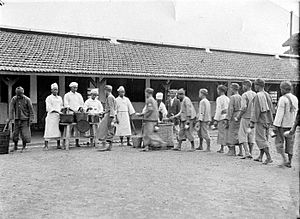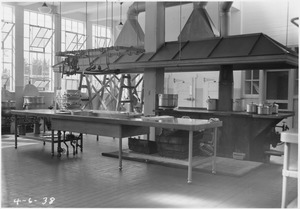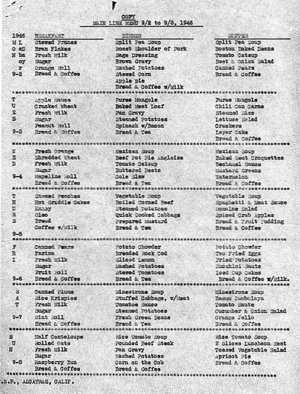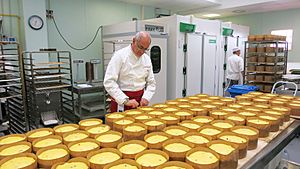Prison food facts for kids

Prison food is the name for meals given to people held in prisons. Some prisons cook their own food. Others use companies that specialize in providing meals. Prisons often try to meet special food needs. This includes meals for different religions or for people who are vegetarian.
Prisoners usually get standard meals each day. But in many prisons, they can buy extra food. This might include snacks or desserts. They buy these items from the prison commissary. They use money earned from working in the prison or sent by family and friends.
Contents
Prison Food Around the World
North America
United States


Prison meals in the U.S. are usually low in sugar and salt. They also have a moderate amount of calories. Prisons try to consider special diets. This includes religious or ethical food choices.
For example, Jewish prisoners may receive kosher meals. Since 2016, federal prisons offer vegan meal options. This includes breakfast, lunch, and dinner.
Most prison food in the U.S. is made using the "blast-chill method." This means many meals are cooked at once. Then they are quickly cooled and stored. Later, they are reheated when it's time to eat. This method was first used in New Jersey prisons in 1982.
Prisoners can also buy food from the prison commissary. Popular items include chocolate bars, beef jerky, peanut butter, bread, ramen noodles, and coffee.
Sometimes, private companies handle all the food preparation. They train staff and make sure food is safe. They also control how much food each person gets.
Prisoners can complain if they think the food is not good enough. These complaints are often about basic rights. For example, very bad food might be seen as "cruel and unusual punishment." This is against the Eighth Amendment of the U.S. Constitution. Also, denying food for religious reasons might go against the First Amendment.
What's on the Menu?
Here is an example of a meal from a state prison:
- 2–3 ounces of meat or a meat product
- Half a cup of vegetables
- Three-quarters of a cup of a starch (like potatoes or rice)
- Three-quarters of a cup of salad with dressing
There have been concerns about prison food. Some reports mention mass illnesses from food. There have also been hunger strikes by prisoners. They protest food that makes them sick. Some people have reported finding mouse droppings in prison kitchens.
Families are usually not allowed to bring fresh food to prisoners. Instead, they can send money. This money lets prisoners buy packaged foods. These include noodle packages and candy from the prison store. This means prisoners often don't get fresh food.
Some companies, like Aramark, have been criticized. They are accused of lowering food standards. They are also said to not provide enough good food.
In federal prisons, breakfast often includes a danish, hot or cold cereal, and milk. Lunch and dinner might have chicken, hamburgers, hot dogs, lasagna, burritos, tacos, or fish patties. Prisoners get milk only in the mornings. For other meals, they have water and a flavored drink.
Prisoners sometimes make their own meals. These are called prison "spreads." They use items bought from the commissary or saved from prison meals. Spreads are often shared among prisoners. Everyone usually brings something to the meal. These spreads are often made because the prison food isn't good enough.
Europe
United Kingdom
In the late 1830s, prisoners in the UK received simple meals. They got a spoon, a zinc dish for broth, and a small bowl for milk. Sometimes, if milk was scarce, they got treacle water.
Rules were strict about how much food prisoners received. For example, a female prisoner not working got about one and a half pints of broth and six ounces of bread. A male prisoner who was working got two pints of broth and twelve ounces of bread.
Breakfast was at 7:30 am. It included 5 ounces of oatmeal porridge with milk. Lunch was at 12:00 pm. It had soup and bread. The soup had to contain meat bones, barley, green peas, leeks, and other vegetables. Supper was at 6:00 pm. It was 5 ounces of oatmeal porridge and milk.
Until about 2004, prisoners often helped prepare meals. They worked under the watch of prison staff. Now, private companies often handle meal preparation. However, in some prisons, like HMP Norwich, prisoners still prepare the meals.
Current Food in UK Prisons
The average amount spent on food per prisoner each day is about £1.87. It can be as low as £1.20. In places for young people, it can be as high as £3.45 per day.
Many prisoners work in the kitchens. This is a popular job because it pays more. It also helps them learn cooking skills.
Meals often use convenience foods. These include canned goods, frozen vegetables, hamburgers, and pies. They usually don't use fresh, seasonal produce.
Example Meals in London Prisons
Here are some examples of meals from a London prison:
Lunch:
- Vegetarian pasta bake
- Chicken & mushroom pie
- Jamaican beef patty
- Corned beef & pickle roll
- Jacket potato & coleslaw
Dinner:
- Vegetable supreme
- Chicken supreme
- Chicken curry
- Grilled gammon
- Pork pie salad
Africa
Egypt
Meals for prisoners in Egypt are basic. For lunch, they might get cold boiled meat, eggs, or chicken bones. They also get white rice and vegetable soup. Dinner often includes ful medames (a traditional Egyptian dish made from fava beans) with stale bread.
Each prison has a canteen. Prisoners can buy extra food there. This includes meat, vegetables, and fruits. Many prisoners also get food brought by their families.
Rwanda
Prisoners in Rwanda get two basic meals a day. Breakfast is usually maize or sorghum porridge. Lunch or dinner is a maize porridge called Ugali and beans. Extra food can be bought at the prison canteen. Visitors can also bring food.
Asia
Saudi Arabia
Prisoners in Saudi Arabia are served bread and sandwiches for breakfast. For lunch, they might have chicken, mutton, or fish. Dinner often includes rice and vegetables. Prisoners also get salads, milk, and juice.
South Korea
Kongbap is a common food in Korean prisons. It's a dish of white or brown rice cooked with grains, peas, and beans. For breakfast, prisoners might get bread with tomato sauce, cheese, soup, salad, and soy milk. Lunch often includes bone marrow and vegetable soup, kimchi, and beansprouts. Prisoners can buy fruits and meats at prison stores.
Vietnam
Each prisoner in Vietnam is supposed to get a certain amount of food each month. This includes 17 kilograms of rice, 15 kilograms of vegetables, and smaller amounts of meat, fish, sugar, and salt.
Special Prison Foods
- Last meal – In the United States, prisoners on death row can choose a last meal. This meal is served two hours before their execution. Studies show that these meals are often high in calories and fat. Examples include french fries and hamburgers. The cost of a last meal is limited. For example, it's $20 in Texas and up to $50 in California. The meal must also be available locally. If a prisoner asks for too much, the portions might be smaller. For instance, a Texas prisoner who asked for 24 tacos got only 4.
- Nutraloaf – Nutraloaf is a special food given to prisoners who misbehave. It's usually a blended mix of previous days' meals. It's often described as bland and like cardboard. But it has all the vitamins and nutrients needed to stay healthy. Giving prisoners nutraloaf is a debated topic. Some people think it's unfair. But prison staff say it helps reduce violence.
- Mystery meat – This is a general term for processed meat. It's often similar to bologna sausage.
- Porridge – This was once a main food in UK prisons.
- Ričet – This is a European stew. It's made with barley, beans, vegetables, and pork. It's sometimes linked to prisons.
- Gruel – This is a thin porridge.


